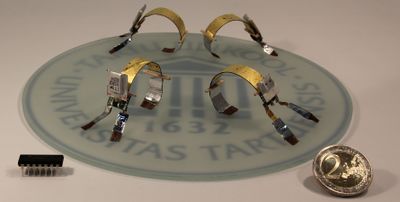Soft Robotics: Difference between revisions
(→Porfolio: Research Projects subsection is added) |
|||
| (21 intermediate revisions by 3 users not shown) | |||
| Line 1: | Line 1: | ||
= Soft robotics | [[File:FourICLrobotsCover.jpg|400px|thumb|right| Miniature energy-autonomous robots with soft actuators]] | ||
== Our vision and goal == | |||
Soft robotics bridges life and robotics. Soft robots demonstrate qualities similar to natural beings, thus allowing to automate tasks previously considered exclusive for humans and other living nature. We design a framework for robots with natural-like interactions with unstructured environments and with delicate objects such as human bodies. First, we develop novel electroactive materials as robotic actuators and sensors. Next, we identify and implement function-specific movement mechanisms that are effective and specific for shape-morphing materials and structures, often finding inspiration from the nature. Finally, we develop applications in the fields of personal medicine, minimally invasive medical instruments, wearable devices, surveillance and rescue. | |||
== | == Highlights == | ||
* UT was first to demonstrate power-autonomous terrestrial robots propelled by artificial muscles | |||
[[ | * We have developed a method for building ionic artificial muscles on textile substrate | ||
* We can build soft laminated materials that actuate and sense motion | |||
== Capabilities == | |||
We develop soft robots in three stages | |||
# New bottom-up fabrication methods for robotic materials | |||
# Tailoring the interactions between the robotic materials and the environment | |||
# Prototyping of soft electro-ionic devices | |||
=== Tools we use === | |||
* Additive fabrication methods for building soft electroactive laminates | |||
* Electrochemical and electromechanical impedance spectroscopy | |||
* Microelectronic control of soft actuators | |||
=== Equipment === | |||
* Customized spray-coating set-up | |||
* Electromechanical testbenches with full electronic control | |||
* Computer vision set-up for robotics materials characterization | |||
* In-situ characterization of robotic materials using scanning electron microscopy | |||
* Dynamic mechanical analysis of robotic materials in a controlled atmosphere | |||
* Thermal imaging of robot's action | |||
== Primary contacts == | |||
{{Team| | |||
{{TeamMember|Indrekm|Indrek Must|associate professor}} | |||
{{TeamMember|Alvo|Alvo Aabloo|professor, head of the lab}} | |||
}} | |||
== Some completed student projects == | |||
* A self-rolling wheel based on artificial muscles | |||
* An insect-inspored walking robot with artificial muscles | |||
* Spray-fabrication of artificial muscles on glass fiber cloth | |||
* Measurement device for characterization of mechano-sensing laminates | |||
* Measurement device for mechanical properties of soft laminates | |||
== Possible topics for students' projects == | |||
[[Soft robotics student projects|List of currently active and timely projects are here]] | |||
== Porfolio == | |||
=== Research Projects === | |||
... | |||
=== Selected Publications === | |||
[https://onlinelibrary.wiley.com/doi/full/10.1002/adem.201400246 Must, Indrek, et al. "Ionic and capacitive artificial muscle for biomimetic soft robotics." ''Advanced Engineering Materials'' 17.1 (2015): 84-94.]] | |||
[https://www.sciencedirect.com/science/article/pii/S0925400517302927 Kaasik, Friedrich, et al. "Scalable fabrication of ionic and capacitive laminate actuators for soft robotics." ''Sensors and Actuators B: Chemical'' 246 (2017): 154-163.]] | |||
=== Outreach === | |||
* [https://www.uttv.ee/naita?id=27125 Pehmed robotid rasketes ülesannetes (liftikõne)] | |||
* [https://www.youtube.com/channel/UC186z2gc0XiLh12hNvPZdUQ Youtube channel: Smart Materials & Soft Robotics ] | |||
Latest revision as of 10:32, 14 August 2019
Our vision and goal
Soft robotics bridges life and robotics. Soft robots demonstrate qualities similar to natural beings, thus allowing to automate tasks previously considered exclusive for humans and other living nature. We design a framework for robots with natural-like interactions with unstructured environments and with delicate objects such as human bodies. First, we develop novel electroactive materials as robotic actuators and sensors. Next, we identify and implement function-specific movement mechanisms that are effective and specific for shape-morphing materials and structures, often finding inspiration from the nature. Finally, we develop applications in the fields of personal medicine, minimally invasive medical instruments, wearable devices, surveillance and rescue.
Highlights
- UT was first to demonstrate power-autonomous terrestrial robots propelled by artificial muscles
- We have developed a method for building ionic artificial muscles on textile substrate
- We can build soft laminated materials that actuate and sense motion
Capabilities
We develop soft robots in three stages
- New bottom-up fabrication methods for robotic materials
- Tailoring the interactions between the robotic materials and the environment
- Prototyping of soft electro-ionic devices
Tools we use
- Additive fabrication methods for building soft electroactive laminates
- Electrochemical and electromechanical impedance spectroscopy
- Microelectronic control of soft actuators
Equipment
- Customized spray-coating set-up
- Electromechanical testbenches with full electronic control
- Computer vision set-up for robotics materials characterization
- In-situ characterization of robotic materials using scanning electron microscopy
- Dynamic mechanical analysis of robotic materials in a controlled atmosphere
- Thermal imaging of robot's action
Primary contacts
Some completed student projects
- A self-rolling wheel based on artificial muscles
- An insect-inspored walking robot with artificial muscles
- Spray-fabrication of artificial muscles on glass fiber cloth
- Measurement device for characterization of mechano-sensing laminates
- Measurement device for mechanical properties of soft laminates
Possible topics for students' projects
List of currently active and timely projects are here
Porfolio
Research Projects
...
